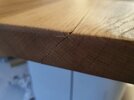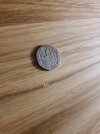The chip I meant is in the middle of the oak worktop - well looking again it may not be a chip and a small imperfection in the wood
Chips are always a bit more of an issue in solid wood. The comments about glue and sawdust being a highly visible bodge still apply, however - do that and you will forever see the flaw, it will draw the eye, particularly as it won't absorb any finish (e.g. oil) evenly
Unfortunately, because you've already had everything cut to size that may (or may not) have reduced your option to cut the defect out (at the end of a piece), or cut the top in such a way as to place it in a sink or hob cut-out position. As a woodworking solution, if you attempt to sand or plane out a chip you'll end up with a hollow area which will be where water pools, if given the chance, but also any hollow will also be quite visible under all finishes other than a flat matt finish. So I think that leaves you with four main options:
(i) Contact the "plastic man" (e.g. Plastic Surgeon). These guys can sometimes do an invisible repair on a worktop, but normally that would be after installation has been done, and it won't come cheap. They have sort of taken over from the French polishers who used to come to site to tint-in and do minor cosmetic repairs on solid wood work (commercial builds)
(ii) Do a surface patch repair where a shallow piece is routed out of the surface, one stave wide, and a near matching, tightly fitting piece of timber is glued in (and clamped) then planed in nearly flush and finally sanded flush. The timber can possibly be taken from the underside of the same piece of worktop or from the sink cut-out, if there is one. This requires a modicum of woodworking ability to pull off a neat repair.
(iii) Use a Forstner bit to drill out the damaged section then add-in a repair - this can either be a near match piece of circular timber, or a contrasting timber or even something like a coin (possibly with this year's date). Call this trying to make a feature out of a problem.
(iv) The workshop approach: find a joinery or furniture making shop locally who possess a wide belt sander and get them to pass all the tops through their sander to reduce the thickness by the depth of the damage. The radiused edge will also need to be remachined afterwards
As a joiner I think I'd look to doing options (ii) or (iv), but that is dependent on a combination of knowledge and access to a shop with a wide belt sander who would be able to help me (he's actually a kitchen manufacturer who makes his own solid wood doors). In your area you might rank things differently



